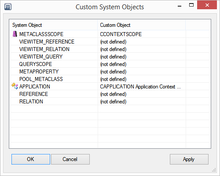Difference between revisions of "Custom System Objects Dialog"
| Line 1: | Line 1: | ||
[[File:UI_CustomSystemObjects.png|thumb|220px|upright|alt=CustomSystem Objects| Custom System Objects]] | [[File:UI_CustomSystemObjects.png|thumb|220px|upright|alt=CustomSystem Objects| Custom System Objects]] | ||
| − | Locate and click the menu ''Database → Custom System Objects'' | + | Locate and click the menu ''Database → Custom System Objects''. |
| − | + | One row of the custom system objects settings consist of two columns, each row representing a system object. Each system object in the list can be configured individually by selecting its customizing representation that is used for automated actions within the {{UBIK}} system (e.g. creating new relations etc.). If a row is clicked within the right column the custom object can be selected out of all suitable customizing objects displayed in a popup list. | |
| + | |||
| + | Press {{key press|Apply}} or {{key press|OK}} when you're finished changing the settings, or {{key press|Cancel}} if you don't want your changes to be saved. The custom system objects will be saved to the current database. | ||
{| class="wikitable" | width = "50%" | {| class="wikitable" | width = "50%" | ||
Revision as of 06:52, 29 July 2014
Locate and click the menu Database → Custom System Objects.
One row of the custom system objects settings consist of two columns, each row representing a system object. Each system object in the list can be configured individually by selecting its customizing representation that is used for automated actions within the UBIK® system (e.g. creating new relations etc.). If a row is clicked within the right column the custom object can be selected out of all suitable customizing objects displayed in a popup list.
Press Apply or OK when you're finished changing the settings, or Cancel if you don't want your changes to be saved. The custom system objects will be saved to the current database.
| Column | Purpose |
|---|---|
| System Object | The system object to configure. |
| Custom Object | The custom object to use instead of the standard system object. |

